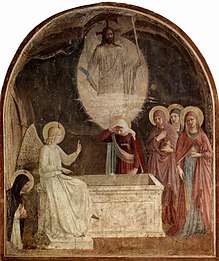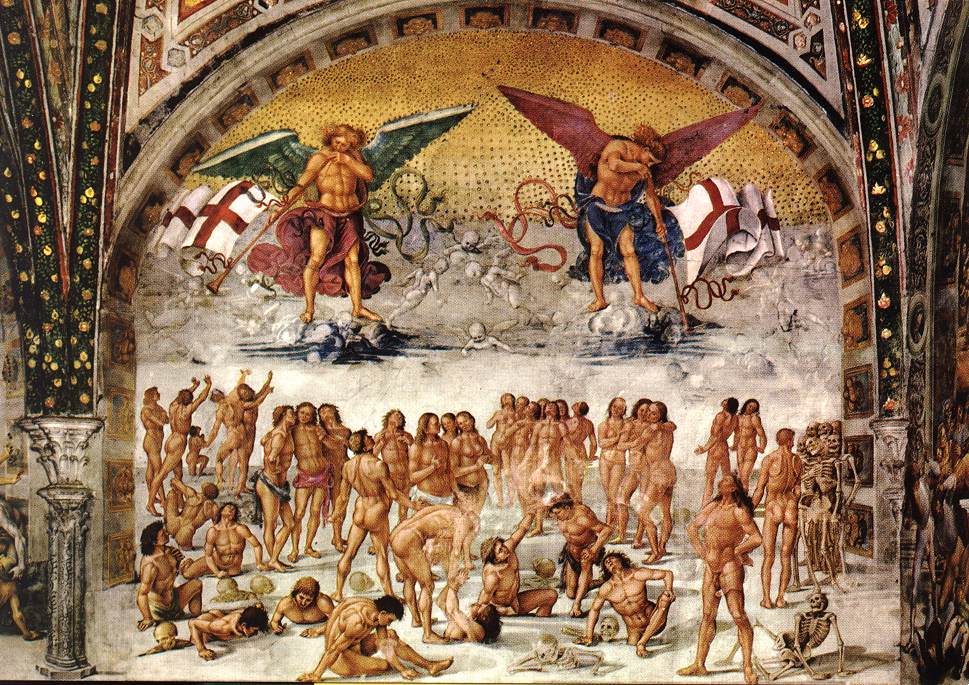Now the green blade riseth from the buried grain,
Wheat that in dark earth many days has lain;
Love lives again, that with the dead has been:
Love is come again, like wheat that springeth green.
In the grave they laid him, love whom men had slain,
Thinking that never he would wake again.
Laid in the earth like grain that sleeps unseen:
Love is come again, like wheat that springeth green,
Forth he came at Easter, like the risen grain,
He that for three days in the grave had lain.
Quick from the dead my risen Lord is seen:
Love is come again, like wheat that springeth green.
When our hearts are wintry, grieving, or in pain,
Thy touch can call us back to life again;
Fields of our hearts that dead and bare have been:
Love is come again, like wheat that springeth green.
– John Macleod Campbell Crum (1872-1958)
Set me as a seal upon thine heart, as a seal upon thine arm: for love is strong as death; jealousy is cruel as the grave: the coals thereof are coals of fire, which hath a most vehement flame.
Many waters cannot quench love, neither can the floods drown it: if a man would give all the substance of his house for love, it would utterly be contemned. — Song of Solomon 8: 6-7 (KJV)
For I delivered unto you first of all that which I also received, how that Christ died for our sins according to the scriptures; And that he was buried, and that he rose again the third day according to the scriptures: And that he was seen of Cephas, then of the twelve: After that, he was seen of above five hundred brethren at once; of whom the greater part remain unto this present, but some are fallen asleep. After that, he was seen of James; then of all the apostles. And last of all he was seen of me also, as of one born out of due time.
— I Corinthians 15: 3-8
My favorite liturgy of the entire Christian year is the ancient service which dates back to the second century called the Great Vigil of Easter. In the Episcopal Church’s Altar Book, the rubrics for this liturgy begin with “in the darkness, a new fire is kindled.” If you have never experienced an Easter Vigil, it is difficult to convey to you the powerful dramatic imagery that plays out in this service. When one enters a church that is completely and utterly cast in darkness, fumbling in the gloom — for safety reasons, most churches allow just enough light for people to safely find their seats — he is brought face to face with a reminder of the darkness of death and the Saviour’s tomb. Each person present holds an unlit taper. There is an expectant air over the hushed worshipers. A priest knocks loudly three times on the church’s door, which is opened and he comes quickly inside. A prayer is said. The new fire is lit, from which the Paschal candle — a symbol of the resurrection — is also lit. Slowly, the new fire is shared among all the congregants who have been holding unlit tapers while the Paschal candle moves slowly to the front of the church and a cantor thrice intones the words “The Light of Christ” to which the people respond “Thanks be to God.”
Then a deacon or a cantor chants the Exsultet, an ancient hymn specifically composed for this liturgy, which enjoins the saints and angels to rejoice in heaven and all Christians on earth to rejoice for “This is the night when Jesus Christ broke the chains of death and rose triumphant from the grave.” By candlelight, passages from the Old Testament which foreshadow the resurrection narrative are read. Psalms are sung. New catechumens are baptized and received into the church.
Then the Easter proclamation is made: “The Lord is Risen. He is Risen indeed. Alleluia!” The people shout their reply. A Great Noise is made to symbolize the stone being rolled from the tomb, the church is suddenly ablaze with light, and the congregation burts forth in song as the angels’ hymn Gloria in excelsis (Glory to God in the highest and on earth peace, goodwill) is sung. The first Eucharist (Holy Communion service) of Easter is celebrated, according to the ancient customary.
It is a liturgy which viscerally evokes the resurrection, and I am always moved to tears to be a part of it. This year, I had the terrifying privilege to be the one who chanted that fifth century hymn, The Exsultet, in my parish church. My voice was tired from intoning the Passion gospel on Good Friday; a combination of allergies and a viral “frog in the throat” made the job a little more difficult than I had bargained for. But being swept up in the beauty of the plainsong’s melodic formula, inspired by the beautiful imagery of the text, and as a vessel for grace quite apart from myself, I managed… and the drama of the resurrection was once more reenacted in the suburban parish where I am organist and choirmaster. He is risen, indeed… and I am exhausted!
Now if Christ be preached that he rose from the dead, how say some among you that there is no resurrection of the dead? But if there be no resurrection of the dead, then is Christ not risen: And if Christ be not risen, then is our preaching vain, and your faith is also vain. Yea, and we are found false witnesses of God; because we have testified of God that he raised up Christ: whom he raised not up, if so be that the dead rise not. For if the dead rise not, then is not Christ raised:And if Christ be not raised, your faith is vain; ye are yet in your sins.Then they also which are fallen asleep in Christ are perished. If in this life only we have hope in Christ, we are of all men most miserable. — I Corinthians 15: 12-19
It’s an impossible story, this resurrection business. The story of Jesus being born to a virgin, being both fully human and fully divine, performing miracles, raising a friend from the dead, willingly going to his own execution and then rising the third day from the tomb is just a lot for some people to take. It doesn’t make any rational sense. We know that when people die, they stay dead. We aren’t going to be able to go to the cemetery, open my late Mother’s grave and find her happily awake and glad to see the sun after all these years. People die. Pets die. They don’t come back to life. There will be no zombie apocalypse. The dead stay dead. Death is the end.
The dead stay dead, but not so with Jesus. He didn’t stay dead. The love of the Father for the Son and of the Son for the Father was so great that even the gates of hell could not prevail against it. It is a flame that flickers back to life in the cold darkness of the tomb: The light of Christ. Thanks be to God.
I have long been an avid reader of speculative fiction. The idea of space and time travel appeal to me. I like to imagine impossible things becoming possible. I like to speculate about new scientific discoveries opening new amazing vistas to the human race. Perhaps that is why I have so little trouble with belief. Perhaps that is also why I love my Apple Computer products. I remember when the internet and the web were just a dream. Now I cannot imagine my existence without those things. I know that there is a universe well beyond our capacity to reason within the dimensionality we can can experience with our five senses. I know that scientists believe there are many more than just four dimensions. I have a layman’s understanding of quantum mechanics. I am aware of its implicit paradoxes, like the thought experiment of Schrödinger’s cat.

The Resurrection, Gustav Dore (1832-1883)
The Bible was not meant to be a science textbook. It is a book about God and His relationship to His people. Nonetheless, in St. Peter 3: 8-9 we are offered a clue as to how God relates to the space-time continuum “But, beloved, be not ignorant of this one thing, that one day is with the Lord as a thousand years, and a thousand years as one day. The Lord is not slack concerning his promise, as some men count slackness; but is longsuffering to us-ward, not willing that any should perish, but that all should come to repentance. “ Since He is its author, He is not bound by it.
The Church teaches that Christ “descended to the dead.” In some translations, that is rendered “he descended to hell.” In other words, what happens to us when we die happened to Him. He died. He took our punishment. He spent an eternity apart from God. It was too much for God the Father to be so separated from His Son. It was too much for the Son to be separated from the Father and the Spirit, it was too much for the Spirit to have the sundering of self from self, and so love won. The power of God’s love released a burst of energy that shook the fabric of space-time, that rolled the stone away from the tomb and that raised Christ from the Dead. “Death is swallowed up in victory.” That burst of cosmic energy dazzles us with its intense brightness, piercing the darkness of our understanding: The Light of Christ. Thanks be to God.
But some man will say, How are the dead raised up? and with what body do they come? Thou fool, that which thou sowest is not quickened, except it die: And that which thou sowest, thou sowest not that body that shall be, but bare grain, it may chance of wheat, or of some other grain: But God giveth it a body as it hath pleased him, and to every seed his own body. All flesh is not the same flesh: but there is one kind of flesh of men, another flesh of beasts, another of fishes, and another of birds. There are also celestial bodies, and bodies terrestrial: but the glory of the celestial is one, and the glory of the terrestrial is another. There is one glory of the sun, and another glory of the moon, and another glory of the stars: for one star differeth from another star in glory.
So also is the resurrection of the dead. It is sown in corruption; it is raised in incorruption: It is sown in dishonour; it is raised in glory: it is sown in weakness; it is raised in power: It is sown a natural body; it is raised a spiritual body. There is a natural body, and there is a spiritual body. And so it is written, The first man Adam was made a living soul; the last Adam was made a quickening spirit. Howbeit that was not first which is spiritual, but that which is natural; and afterward that which is spiritual. The first man is of the earth, earthy: the second man is the Lord from heaven. As is the earthy, such are they also that are earthy: and as is the heavenly, such are they also that are heavenly. And as we have borne the image of the earthy, we shall also bear the image of the heavenly. — I Corinthians 15: 35-49
I remember Dr. Bob Jones, Jr. quoting his favorite verse from his favorite evangelistic hymn many times in chapel services when I was a teenager: “Then we shall be where we would be. Then we shall be what we should be. Things that are not now nor could be Soon shall be our own.” That clever word-play sums up the hope we have in the resurrection of Jesus. We don’t know how it will happen or when, but we do know that we will all have our own resurrection someday. The message of the resurrection is that we don’t have to be afraid anymore. We are not alone, even in the valley of the shadow of death. We have Jesus Christ, the Righteous, our Mediator and Advocate at our side, and He will lead us into all truth. He will perfect us in his righteousness.
Who shall separate us from the love of Christ? shall tribulation, or distress, or persecution, or famine, or nakedness, or peril, or sword? As it is written, For your sake we are killed all the day long; we are accounted as sheep for the slaughter.Nay, in all these things we are more than conquerors through him that loved us. For I am persuaded, that neither death, nor life, nor angels, nor principalities, nor powers, nor things present, nor things to come, Nor height, nor depth, nor any other creation, shall be able to separate us from the love of God, which is in Christ Jesus our Lord. — Romans 8: 35-39
My friends, Bob Jones University, Dr. Bob Jones III, fundamentalism, your fundamentalist pastor and your Independent Fundamentalist church are principalities and powers that cannot separate you or me from the love of God in Christ Jesus our Lord. He loves us. He redeemed us. We are His.
All across America, it is beginning to dawn towards the first day of the week. Like Mary Magdalene, gay men and women are bearing witness to this impossible news of the resurrection in their conservative Christian college and university communities as they say “I am Christian and I am gay,” a teenager speaks out to his mother, a conservative Christian Harvard student, Matthew Vines, has claimed the promise of Christ’s love. “Love lives again that with the dead has been. Love is come again like wheat that springeth green.” I am Christian and I am gay. And that is okay.
Into the darkness of misunderstanding and abuse a new fire is kindled: The Light of Christ. Thanks be to God.
Jeffrey Hoffman
provisional Executive Director
lgbt-BJU.org





